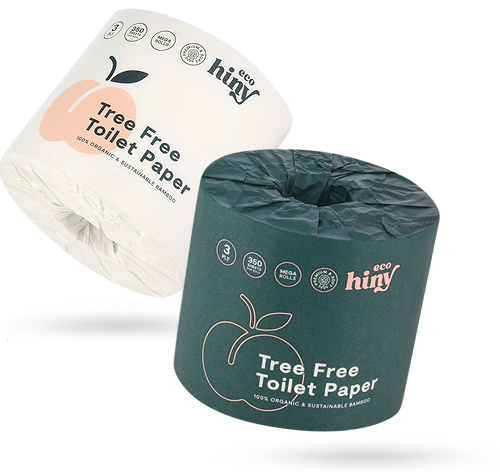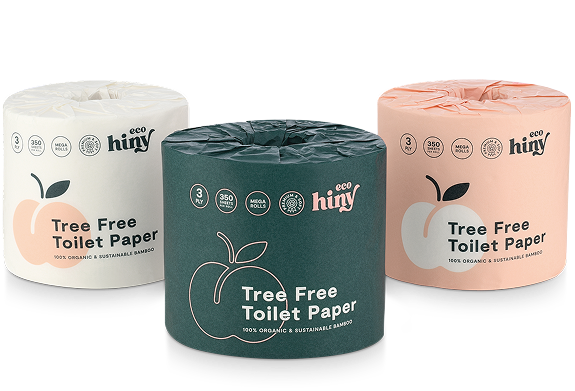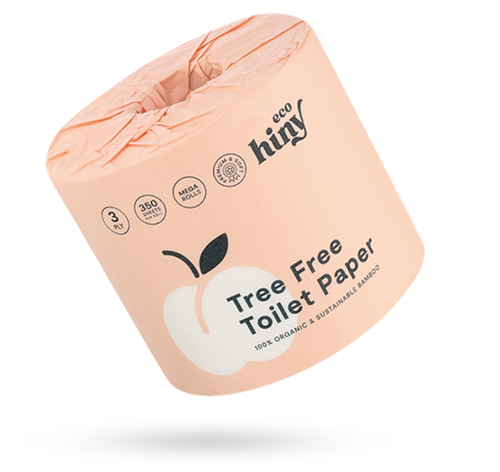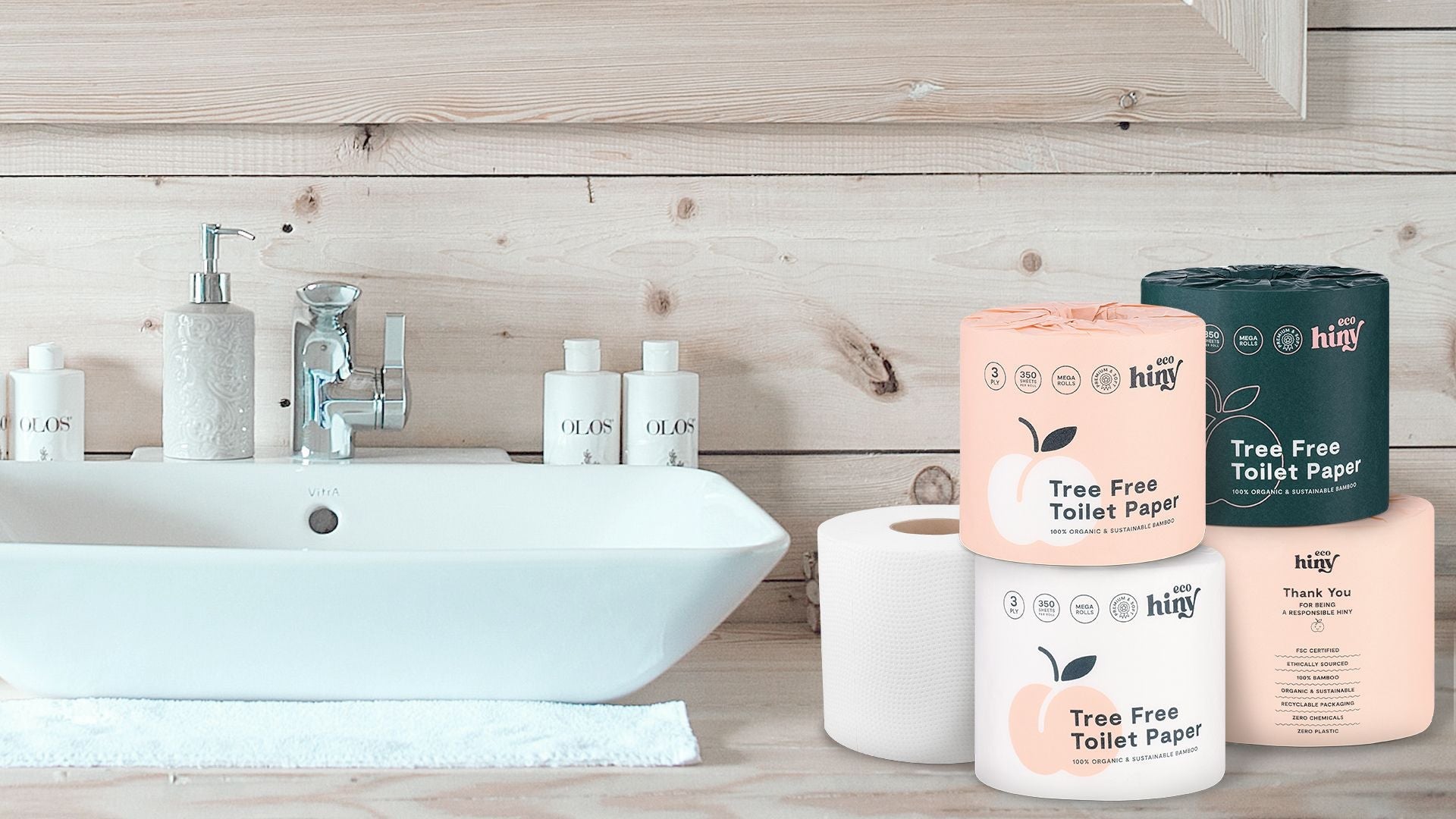Key Points
- PFAS are toxic "forever chemicals" found in many conventional toilet papers, posing health risks like hormone disruption, cancer, and immune system issues.
- ecoHiny’s bamboo toilet paper is completely PFAS-free, along with being free from dyes, fragrances, BPA, and chlorine—making it a safer choice for your health.
- Choosing bamboo toilet paper supports a healthier planet, thanks to its rapid regrowth, low water use, and pesticide-free cultivation.
When it comes to what we value, health is at the top for us here at ecoHiny. We're committed to improving the health of the planet and offering the safest and healthiest toilet paper option for you.
Safeguarding your health and helping our earth means making sure only the purest and most natural ingredients make their way into our toilet paper.
You can already rest assured that ecoHiny bamboo toilet paper is free of:
- Dyes
- Fragrances
- BPA (Bisphenol-A)
- Elemental chlorine
- Formaldehyde
- Trees
However, if you're using traditional toilet paper, it's likely there are plenty of additives and chemicals included on that roll.
Chemicals are a part of how traditional toilet paper is made. The paper used in toilet paper production is made from wood pulp, which is then bleached to give it the white color that we are all familiar with. Chemicals such as chlorine and hydrogen peroxide are used in this bleaching process.
Additionally, chemicals such as starch and latex are added to the paper to improve its strength and absorbency. Another chemical possibly added to accomplish this? Substances called PFAS.

Hypoallergenic,BPA-Free, PFAS-Free, Elemental Chlorine-Free
ecoHiny's 3-ply bamboo toilet paper.
From $15.99
What are PFAS and What's Made With Them?
PFAS stands for Per- and poly-fluoroalkyl substances, which are a group of man-made chemicals that are commonly used in various industrial and consumer products. They have been widely used for decades in products in various industrial and consumer products due to their unique properties such as thermal stability, water and oil repellency, and nonstick characteristics.
Many items in your household likely contain PFAS. (1) Some common places they're found include:
- Cleaning products
- Water-resistant fabrics like umbrellas, rain jackets, and tents
- Grease-resistant paper
- Nonstick cookware
- Personal care products like shampoo, dental floss, eye makeup
- Stain resistant fabrics
- Food packaging
- Firefighting foam
You can also be exposed to PFAS by:
- Drinking contaminated municipal or private well water
- Eating fish with high levels of PFAS
- Eating food grown or raised near places that used or made PFAS
- Eating food packaged in material made with PFAS
- Swallowing contaminated soil or dust
- Using some consumer products, such as ski wax, nonstick cookware, and stain and water-repellant sprays for fabrics
Unfortunately, PFAS chemicals are persistent in the environment and can accumulate in people and animals over time, potentially causing harm to human health and the environment.
Exposure to PFAS has been linked to several adverse health effects, such as developmental and reproductive problems, liver and kidney damage, immune system dysfunction, and some types of cancer. (2)
The accumulation of PFAS in the environment has also been identified as a significant concern, as they do not break down easily and can persist for decades, leading to long-term environmental contamination.
As we mentioned, another place you might find PFAS is your toilet paper.
When it comes to what's on your toilet paper roll, PFAS can enter the product through a few different pathways. One possible source is recycled paper products that contain PFAS. When these products are recycled, the chemicals can be carried over into new paper products, including toilet paper.
According to the American Chemical Society, some paper manufacturers add PFAS when converting wood into pulp, which can get left behind and contaminate the final paper product. (3) In some cases, companies add PFAS to increase the absorbency and strength of their toilet paper.
The Importance of PFAS Free Toilet Paper
According to the American Association for the Advancement of Science, "PFAS are often referred to as "forever chemicals" because they do not easily break down in the environment and are difficult to destroy." (4)
So here's why we want you to avoid toxic toilet paper and choose a more eco-friendly toilet paper option.
Winding Up in Wastewater
PFAS can enter our water sources in several ways. One common way is through industrial discharge, where companies dispose of PFAS-containing waste into nearby bodies of water.
PFAS can also seep into the soil and contaminate groundwater sources, which can then find their way into our drinking water. In addition, disposing of PFAS-containing products means they can enter the environment and contribute to the contamination of our water sources.
Once PFAS is in the water supply, it can be difficult to remove, making it a concerning issue for public health and the environment.
Health Hazards
According to the EPA, current peer-reviewed scientific studies have shown that exposure to certain levels of PFAS may lead to:
- Reproductive effects such as decreased fertility or increased high blood pressure in pregnant women
- Developmental effects or delays in children, low birth weight, accelerated puberty, bone variations, or behavioral changes
- Increased risk of some cancers, including prostate, kidney, and testicular cancers
- Reduced ability of the body's immune system to fight infections, including reduced vaccine response
- Interference with the body's natural hormones
- Increased cholesterol levels and/or risk of obesity
Surveys conducted by the CDC indicate that most people in the U.S. have been exposed to PFAS. (5)
Overall, it is important to be aware of the potential presence of PFAS in toilet paper and other paper products and to advocate for safer alternatives that do not contain these harmful chemicals.
Enter ecoHiny.
EcoHiny the PFAS-Free Toilet Paper
EcoHiny is your brand for buying sustainable and committing to eco-friendly practices. We're not just the alternative to harmful PFAS-filled products, but we're also the option for sustainable, all-natural, 100% tree-free toilet paper.
The Ways Bamboo is Better for the Environment
Bamboo is a super sustainable material. Its rapid growth makes it a significantly better source of paper than hardwood trees. It regenerates quickly, unlike hardwood trees, which can take years to mature.
Bamboo does not require the use of fertilizers or pesticides to thrive and also uses less water to establish and grow than hardwood trees. This means bamboo crops aren't contributing to harmful chemicals making their way to our waterways and infusing our soil.
Speaking of soil, harvesting bamboo doesn't require soil disruption. Bamboo can be cut and then regrow from its existing stalks. That's because bamboo is truly a grass and not a tree at all! Root systems remain intact, and so do delicate ecosystems living in the soil.
The Ways Bamboo is Better for Your Body
Bamboo fibers are exceptionally long. This contributes to bamboo toilet paper's incredible softness. The fibers are pliable and flexible and make for a perfectly comfortable feel.
The natural antibacterial and hypoallergenic properties of bamboo translate into our toilet paper, too! The National Library of Medicine concludes that unbleached toilet paper that has been minimally processed with chemicals is the best option for avoiding skin irritation. (6) If you have sensitive skin, bamboo is going to be right for you.

Hypoallergenic,BPA-Free, PFAS-Free, Elemental Chlorine-Free
ecoHiny's 3-ply bamboo toilet paper.
From $15.99
EcoHiny's Commitment
We guarantee that our bamboo toilet paper rolls are made with nothing more than 100% responsibly sourced bamboo from Forest Council-certified lands. Not only are we tree-free, but PFAS never make their way into our production. We leave out all the other chemicals as well. The reality is, with bamboo, you don't need anything else! It's a natural "no-brainer" when it comes to toilet paper.
Our packaging is just as eco-friendly. We don't include plastic, and all wrappers and boxes are biodegradable and recyclable. It's safe for all types of toilet systems, and our carbon-neutral shipping practices mean sustainability every step of the way.
Want to make it even easier? Subscribe, and not only will you save money, but you'll ensure that you never run short on this significant household necessity.
PFAS free toilet paper is an important step in safeguarding your health. Eliminate the possibility of PFAS entering your home through your toilet paper, and join us in making health wiping a priority for you, your family, and the planet.
Source:
- "Chemicals: Perfluoroalkyl and Polyfluoroalkyl (PFAS) Substances." Wisconsin Department of Health Services, www.dhs.wisconsin.gov/chemical/pfas.htm#:~:text=Grease%
2Dresistant%20paper.,%2C%
20upholstery%2C%20and%20other%20fabrics. - "What are the health effects of PFAS?" Agency for Toxic Substances and Disease Registry, CDC, www.atsdr.cdc.gov/pfas/health-effects/index.html.
- "Toilet paper is an unexpected source of PFAS in wastewater, study says." American Chemistry Society, Mar. 2023, www.acs.org/pressroom/presspacs/2023/march/toilet-paper-is-an-unexpected-source-of-pfas-in-wastewater.html#:~:text=Toilet%
20paper%20from%
20around%20the,%E2%80%9Cforever%20chemicals%E2%80%9D%20. - "Per- and Polyfluoroalkyl Substances (PFAS) in Drinking Water." American Association for the Advancement of Science, www.aaas.org/epi-center/pfas#:~:text=PFAS%2C%20often%20referred%
20to%20as,using%20conventional%20water%20treatment%20processes. - "Our Current Understanding of the Human Health and Environmental Risks of PFAS." United States Environmental Protection Agency, www.epa.gov/pfas/our-current-understanding-human-health-and-environmental-risks-pfas.
"Chronic vulvar irritation: could toilet paper be the culprit?"National Library of Medicine, www.ncbi.nlm.nih.gov/pmc/articles/PMC2860827/.

Hypoallergenic,BPA-Free, PFAS-Free, Elemental Chlorine-Free
ecoHiny's 3-ply bamboo toilet paper.
From $15.99

Hypoallergenic,BPA-Free, PFAS-Free, Elemental Chlorine-Free
ecoHiny's 3-ply bamboo toilet paper.
From $15.99





